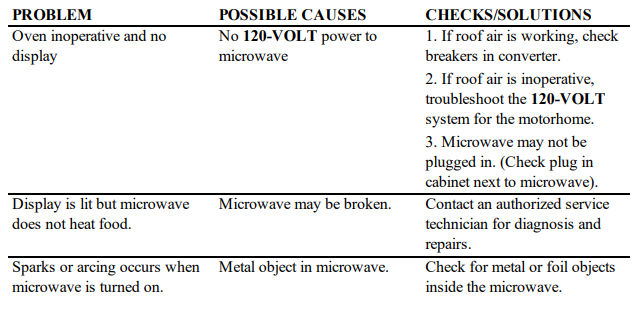07 The 120-VOLT Appliances
The Microwave Oven
ABOUT THE MICROWAVE
The microwave is manufactured for motorhome use only. Altitude and the kind of cookware used can affect cooking times.
NOTE: The microwave operates on 120- VOLT only. To use the microwave you must have the shoreline plugged into either a campground receptacle or the generator outlet.

If you are plugged into the generator outlet, the generator must be running in order for there to be 120-VOLT AC.
Like with all microwaves, there are certain things that should not be put into it.
NOT RECOMMENDED:
- • Glass jars - they may shatter.
- • Paper bags - they create a fire hazard - except popcorn bags intended for the microwave.
- • Styrofoam plates or cups - they may melt.
- • Plastic containers - they may melt.
- • Metal utensils and wire ties for bread bags.
- • Never use dishes with metallic rims.
- • Aluminum foil.
RECOMMENDED:
- • Glass or ceramic plates and bowls.
- • Microwave browning dishes.
- • Microwave plastic wrap, wax paper, paper towels and napkins.
- • paper plates and cups.
TROUBLESHOOTING THE MICROWAVE

Roof Air Conditioner
HOW IT OPERATES
Cool air is generated by recycling the air from inside the motorhome (return air), sending it through the evaporator coils and pushing it back into the motorhome (discharge air) through the air grills (Image 69.1).

NOTE: The roof air conditioner (Image 69.1) operates on 120-VOLT power only. To use 120-VOLT AC, you must have the shore line plugged into either a campground receptacle or the generator outlet.
The generator outlet is located in the shore line compartment on the drivers side of the motorhome. If you are plugged into the generator, the generator must be running in order for there to be 120-VOLT AC power.
NOTE: Before turning off the generator (or unplugging the shore line), turn off the roof air conditioner.
The ability of the air conditioner to cool down or maintain a desired temperature depends upon the heat gain of the motorhome, the size of the motorhome, the amount of windows, exposure to the sunlight and the number of people inside of the motorhome.
AS A RULE, THE AIR WILL BE COOLED 15 TO 20 DEGREES, DEPENDING ON THE OUTSIDE TEMPERATURE AND HUMIDITY.
It is not uncommon to see water dripping from the roof while using the air conditioner in more humid temperatures. Parking the motorhome in shaded areas, keeping curtains and blinds drawn and avoiding the use of heat producing appliances will help reduce the heat gain.
HOW IT OPERATES CONTINUED
When the outdoor temperatures drop in the evening to below 75 degrees farenheit, the temperature control knob should be set midway between WARMER and COOLER. Otherwise the evaporator coil may become iced up and sop cooling.
Should icing up occur, it is necessary to turn the air conditioner off for at least 45 minutes to clear the coil of the ice. Alternatively, you may turn the selector knob to the HI FAN position until increased airflow is observed.
When the air conditioner is in operation, its compressor circulates refrigerant under high pressure. Once it is turned off, it takes three to four minutes to equalize the pressure. Therefore once it is turned off it is important to leave it off for three to four minutes before starting it up again. "Short cycling" the compressor will sometimes trip the circuit breaker.
AIR CONDITIONER START UP
1. From the ceiling assembly, turn the selector switch to the LOW COOL or HIGH COOL position.
2. Rotate the thermostat (temperature control) to the position most comfortable for you.
3. If you feel a reduced amount of air, check the air filters highlighted in Image 69.1 for dust or debris.
TROUBLESHOOTING THE ROOF AIR CONDITIONER

